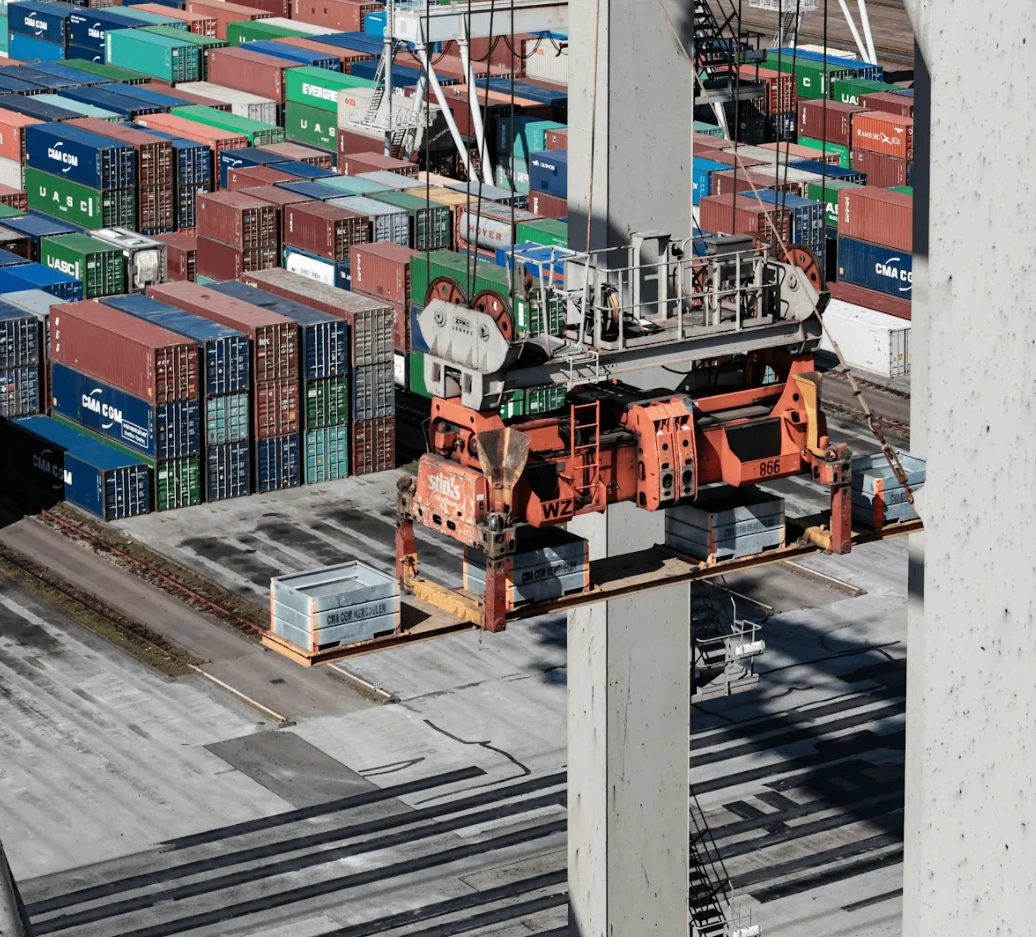Intermodal transportation is an effective solution for international shipping. By leveraging multiple modes of transport, shipping gains flexibility and efficiency, leading to reduced costs and environmental impact. In this article, you will learn more about what intermodal transportation is, its background and benefits, as well as the difference between intermodal and multimodal transport.
What is intermodal transportation?
Intermodal transportation combines various modes of transport in a coherent transport chain. It can involve transport modes such as trucks, trains, and container ships. Intermodal transportation advances the logistics industry by facilitating freight handling and promoting sustainable transport.
The result of intermodal transport is a balance between cost, environmental impact and efficiency.
What does intermodal transportation mean?
Intermodal transportation means that goods are transported from start to destination by using several modes of transport.

What does intermodal transportation mean?
Intermodal transportation means that goods are transported from start to destination by using several modes of transport.
An example of intermodal transportation:
A container of goods is transported from a factory in Sweden to a customer in the US. First, the container is transported by truck to a railway station, where it is reloaded onto a train that takes it to a port. In the port, the container is loaded on board a container ship for sea transport to the United States. Once at the port in the US, the container is loaded onto a truck that delivers the goods to their final destination.
Do you want to learn more about containers? Read our article: What is a shipping container?
What does intermodal transportation mean?
Intermodal transportation means that shipping is simplified by moving the goods between different modes of transport at transshipment terminals. This contributes to lower transport costs, shorter loading times, and reduced environmental impact compared to road transport alone. At the same time, road traffic decreases when rail and sea transport are used to a greater extent.
Goods are usually shipped in a container and remain there throughout the transport. The key to that is the standardization of containers. The standardization makes it possible to use containers over different modes of transport without reloading the goods. In the case of intermodal transportation, it is therefore important to choose the right mode of transport at the right time, as each mode of transport has its own strengths.
Trucks provide flexibility for shorter distances and are often used at the beginning and end of the transport chain. Trains and container ships handle longer distances and form a significant part of the infrastructure.
Pros and cons of intermodal transportation
There are both advantages and disadvantages to intermodal transport. Why is it considered cost-effective and environmentally friendly? And what obstacles might appear along the way? We go through it below.
Advantages of intermodal transportation:
1. Cost-effective
By using rail and sea transport for longer distances, the transport solution becomes more cost-effective. If you only use truck transport on longer distances and for large volumes, it costs more.
Read more about shipping costs and how to calculate them.
2. Better for the environment
Because intermodal transportation combines different modes of transport, the amount of carbon dioxide emitted is reduced. Trains and ships are generally more fuel-efficient per freight unit than road transport alone.
3. Less risk of theft
The risk of theft decreases when goods are transported by rail or sea compared to road transport alone. Rail and shipping are more controlled and therefore safer.
4. Reduced road congestion and accidents
By transporting more freight via rail and sea, pressure on the road network is reduced, resulting in less traffic. This decrease in road congestion also lowers the risk of accidents.
Disadvantages of intermodal transportation:
1. Infrastructure required
Efficient intermodal transport requires well-developed infrastructure – such as ports, rail networks and terminals. It is not always developed in all countries.
2. Less flexibility
Truck transport offers greater flexibility in terms of routes and timings. Trains and ships must follow fixed timetables and routes.
3. Initial investments
Establishing intermodal transport solutions can require significant upfront investments. These may include infrastructure, specialized equipment, staff training, technology, and cooperation agreements with transport providers.
4. Complexity in planning
Coordinating different modes of transport and managing multiple actors can make logistics more complex and require careful planning and coordination.
Intermodal transport impacts both companies and consumers by making goods deliveries more efficient and reducing transport costs. By combining different modes of transport, such as rail, sea and road, companies can optimize their logistics processes and reduce costs. For your company, this means increased efficiency and cost savings by utilizing the strengths of different modes of transport.
For your customers, these savings can result in lower prices, as shipping costs often make up a large portion of product prices. In addition, intermodality contributes to a more reliable supply chain, which means more consistent and reliable delivery times.
Intermodal transportation vs. multimodal transportation
Intermodal transportation is typically confused with multimodal transportation, as both services use two or more transportation methods to transport goods to their final destination. While intermodal transport can be seen as a form of multimodal transport, there are distinct differences.
In multimodal transport, the entire transport is handled under a single agreement. A single carrier assumes responsibility for the entire door-to-door delivery, even if several modes of transport or subcontractors are used along the way.
In the case of intermodal transport, there is a separate agreement for each section. This means that different carriers are responsible for their respective parts of the transport, and the responsibility for a successful delivery is shared between various actors.
Read more about multimodal transport.
The development of intermodal transport
To truly understand the benefits of intermodal transportation, it is important to look at its history. Intermodal transport developed in the 1950s – when international trade increased and the need for more efficient transport of bulk goods became clear. During World War II, American soldiers created raised wooden bases, called pallets, to safely hold and transport goods. The pallets reduced handling time and protected the load from damage. The use of pallets spread quickly and is still today one of the most common tools for shipping.
Intermodal transport: The container revolution
The development of intermodal transportation took off in 1956, when entrepreneur Malcolm McLean had a revolutionary idea – why not load the entire truck directly onto the ship? This thought led to the creation of modern shipping containers, which made loading and unloading much faster and more efficient.
The current success of intermodality
The real turning point came not only from the containers, but from the idea of adapting all modes of transport to integrate with the containers. In 1967, the International Organization for Standardization (ISO) established a standard for containers, known as ISO containers. They have specific measurements and are numbered with a code system for quick identification. Over time, new types of ISO containers, such as tanks and refrigerated containers, were added, further expanding intermodal transport.
Read more about what a shipping container is.
Why choose Bertling for intermodal transportation?

Are you looking for an optimal solution for intermodal transport? Bertling offers customized global transport solutions with high flexibility in our configurations. Our vision is to work proactively and meet new challenges as they arise. Today, we offer a complete range of logistics services, including air- and sea freight, road transport and project logistics. If you're looking to combine different transport modes, we're here to help. Our goal is to provide you with a fast, flexible and environmentally friendly solution.
Contact us to know more about how we can help you with your intermodal transport!
BOOK YOUR INTERMODAL TRANSPORTATION WITH BERTLING
Read also: Which transport solution should you choose?
